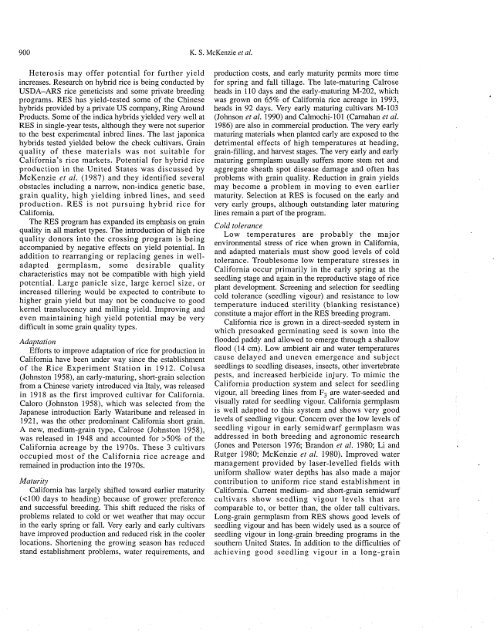McKenzie et al. - 1994 - Breeding improved rice cultivars for temperate reg
McKenzie et al. - 1994 - Breeding improved rice cultivars for temperate reg
McKenzie et al. - 1994 - Breeding improved rice cultivars for temperate reg
Create successful ePaper yourself
Turn your PDF publications into a flip-book with our unique Google optimized e-Paper software.
900 K. S. <strong>McKenzie</strong> <strong>et</strong> <strong>al</strong>.<br />
H<strong>et</strong>erosis may offer potenti<strong>al</strong> <strong>for</strong> further yield<br />
increases. ~esearch on hybrid <strong>rice</strong> is being conducted by<br />
USDA-ARS <strong>rice</strong> gen<strong>et</strong>icists and some private breeding<br />
programs. RES has yield-tested some of the Chinese<br />
hybrids provided by a private US company, Ring Around<br />
Products. Some of the indica hybrids yielded very well at<br />
RES in single-year tests, <strong>al</strong>though they were not superior<br />
to the best experiment<strong>al</strong> inbred lines. The last japonica<br />
hybrids tested yielded below the check <strong>cultivars</strong>. Grain<br />
qu<strong>al</strong>ity of these materi<strong>al</strong>s was not suitable <strong>for</strong><br />
C<strong>al</strong>i<strong>for</strong>nia's <strong>rice</strong> mark<strong>et</strong>s. Potenti<strong>al</strong> <strong>for</strong> hybrid <strong>rice</strong><br />
production in the United States was discussed by<br />
<strong>McKenzie</strong> <strong>et</strong> <strong>al</strong>. (1987) and they identified sever<strong>al</strong><br />
obstacles including a narrow, non-indica gen<strong>et</strong>ic base,<br />
grain qu<strong>al</strong>ity, high yielding inbred lines, and seed<br />
production. RES is not pursuing hybrid <strong>rice</strong> <strong>for</strong><br />
C<strong>al</strong>i<strong>for</strong>nia.<br />
The RES program has expanded its emphasis on grain<br />
qu<strong>al</strong>ity in <strong>al</strong>l mark<strong>et</strong> types. The introduction of high <strong>rice</strong><br />
qu<strong>al</strong>ity donors into the crossing program is being<br />
accompanied by negative effects on yield potenti<strong>al</strong>. In<br />
addition to rearranging or replacing genes in welladapted<br />
germplasm, some desirable qu<strong>al</strong>ity<br />
characteristics may not be compatible with high yield<br />
potenti<strong>al</strong>. Large panicle size, large kernel size, or<br />
increased tillering would be expected to contribute to<br />
higher grain yield but may not be conducive to good<br />
kernel translucency and milling yield. Improving and<br />
even maintaining~high yield potenti<strong>al</strong> may be-very<br />
difficult in some grain qu<strong>al</strong>ity types.<br />
Adaptation<br />
Ef<strong>for</strong>ts to improve adaptation of <strong>rice</strong> <strong>for</strong> production in<br />
C<strong>al</strong>i<strong>for</strong>nia have been under way since the establishment<br />
of the Rice Experiment Station in 1912. Colusa<br />
(Johnston 1958), an early-maturing, short-grain selection<br />
from a Chinese vari<strong>et</strong>y introduced via It<strong>al</strong>y, was released<br />
in 191 8 as the first <strong>improved</strong> cultivar <strong>for</strong> C<strong>al</strong>i<strong>for</strong>nia.<br />
C<strong>al</strong>oro (Johnston 1958), which was selected from the<br />
Japanese introduction Early Wataribune and released in<br />
192 1, was the other predominant C<strong>al</strong>i<strong>for</strong>nia short grain.<br />
A new, medium-grain type, C<strong>al</strong>rose (Johnston 1958),<br />
was released in 1948 and accounted <strong>for</strong> >50% of the<br />
C<strong>al</strong>i<strong>for</strong>nia acreage by the 1970s. These 3 <strong>cultivars</strong><br />
occupied most of the C<strong>al</strong>i<strong>for</strong>nia <strong>rice</strong> acreage and<br />
remained in production into the 1970s.<br />
Maturity<br />
C<strong>al</strong>i<strong>for</strong>nia has largely shifted toward earlier maturity<br />
(

















